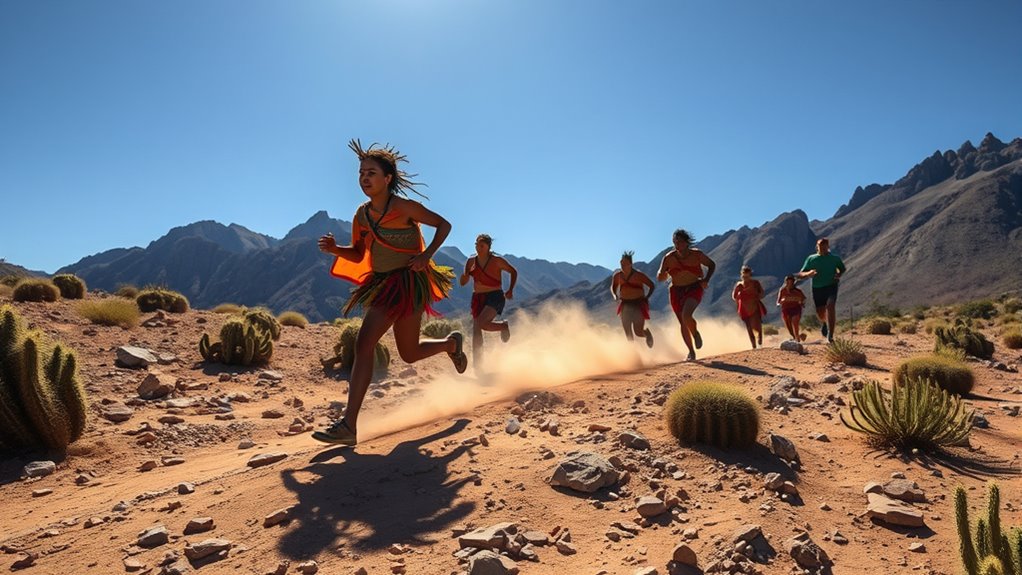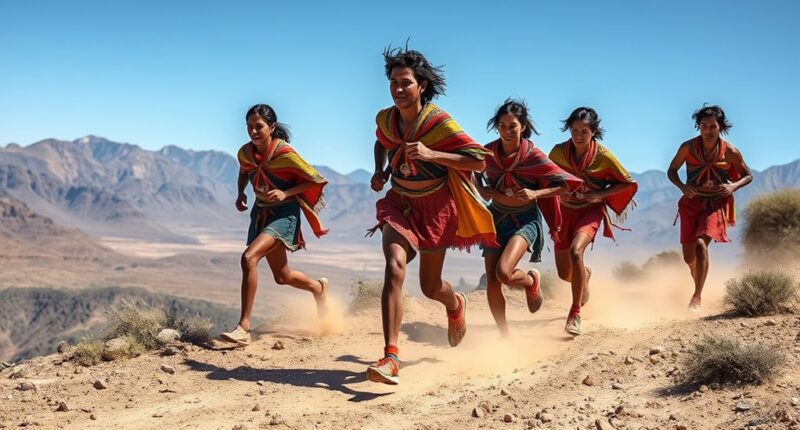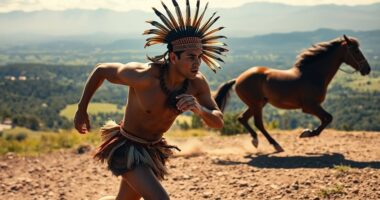Running for the Tarahumara isn’t just exercise—it’s a sacred act woven into their spiritual and cultural life. You’ll see them running barefoot or with simple sandals made from recycled materials, symbolizing respect for nature and resilience. When they run in ceremonies, it’s like offering prayers and honoring ancestors. This deep connection to the land fosters humility, health, and community bonds. Discover how these traditions continue to preserve their identity and spirituality.
Key Takeaways
- Running is a sacred tradition for the Tarahumara, symbolizing spiritual connection, cultural identity, and respect for ancestors.
- They traditionally wear simple sandals made from recycled tires or plant fibers, reflecting sustainable practices.
- Running functions as prayer or offering during ceremonies, reinforcing community bonds and spiritual beliefs.
- Barefoot or minimally shod running fosters a deep unity with the land and natural environment.
- The practice preserves resilience, health, and cultural heritage through storytelling, rituals, and communal participation.

Have you ever wondered how running holds a special place in indigenous cultures around the world? In the case of the Tarahumara, or Rarámuri, running isn’t just a sport; it’s a essential part of their identity, traditions, and spiritual life. From a young age, they learn to run efficiently, often barefoot or with minimal footwear, which is deeply rooted in their cultural practices. Their traditional footwear, typically simple sandals made from recycled tires or plant fibers, reflects their connection to the land and their way of life. These humble shoes aren’t just practical; they carry spiritual significance, symbolizing respect for nature and the ancestral ways that have sustained them for generations.
For the Rarámuri, running is more than physical exercise—it’s a sacred act that links the physical and spiritual worlds. They believe that running connects them to their ancestors and the earth itself. During ceremonial events, they often run as a form of prayer or offering, demonstrating reverence and gratitude. The act of running serves as a way to honor their ancestors’ resilience and their ongoing relationship with the land. This spiritual significance elevates their running beyond mere movement; it becomes a ritual that embodies their cultural identity and spiritual beliefs.
Their traditional footwear plays a role in these spiritual practices. The simplicity of their sandals, often handmade and passed down through generations, embodies humility and respect for nature’s resources. These shoes are more than protection for their feet—they are symbols of their adaptability and spiritual connection. Running barefoot or with minimal footwear allows them to feel the ground beneath their feet, fostering a profound sense of unity with the environment. This intimate contact with the earth reinforces their spiritual philosophy that humans are an integral part of nature, not separate from it.
Moreover, the Tarahumara’s approach to running and their traditional footwear exemplify resilience and harmony with their surroundings. They view running as a way to maintain physical health and spiritual well-being, passing down these practices through storytelling, community gatherings, and rituals. Their footwear, simple yet meaningful, signifies their respect for tradition and their environment. It reminds us that in indigenous cultures, running is more than just a physical activity; it’s a sacred, spiritual act that preserves their cultural heritage and deepens their connection to the land and ancestors.
Frequently Asked Questions
How Do Tarahumara Runners Train Daily?
You train like Tarahumara runners by embracing indigenous endurance and incorporating daily runs that span many miles through rugged terrains. You often run barefoot or with minimal footwear, which strengthens your feet and preserves your cultural practices. Your training reflects a deep connection to cultural preservation, emphasizing community, tradition, and respect for nature. This routine helps maintain your physical resilience and keeps your indigenous heritage alive through active, consistent practice.
What Traditional Footwear Do Tarahumara Use?
You’ll find that the Tarahumara use traditional footwear called huaraches, crafted with indigenous craftsmanship and traditional materials. They make these sandals by weaving leather or rubber straps around a simple sole, often from recycled tires or natural hides. This footwear not only supports their running but also reflects their cultural connection to nature and resourcefulness, allowing them to run comfortably across rugged terrains.
How Does Running Influence Tarahumara Community Life?
Running plays a essential role in your Tarahumara community life, serving as a key cultural activity that fosters community bonding and preserves traditions. It’s more than exercise; it’s a way to connect with ancestors and celebrate shared identity. Through communal runs and races, you strengthen social ties, pass down stories, and uphold cultural significance, ensuring that the spirit of running remains integral to your community’s unity and cultural vitality.
Are Tarahumara Races Open to Outsiders?
You’ll find that Tarahumara races hold a deep cultural significance, and their accessibility to outsiders varies. While some events welcome visitors, others remain intimate, honoring tradition and community spirit. Respectful participation is encouraged, but it’s essential to understand the races’ cultural importance. If you’re enthusiastic to experience this tradition, approach with humility and appreciation, recognizing that these races are more than competition—they’re sacred celebrations of Tarahumara identity.
What Are the Health Benefits of Tarahumara Running Practices?
You’ll find that Tarahumara running practices boost your endurance sports skills and support traditional healing. Their long-distance runs improve cardiovascular health, build stamina, and increase mental resilience. Additionally, engaging in their running customs connects you with traditional healing practices that promote physical and spiritual well-being. Embracing these traditions offers a holistic approach to health, helping you develop resilience and balance through their unique, culturally rich running techniques.
Conclusion
So, despite all the talk about modern technology and fast-paced lives, you might find it ironic that the Tarahumara—the true masters of running—still find joy and purpose in pounding the dirt barefoot or with simple sandals. While we chase gadgets and convenience, they remind us that sometimes, the best way forward is just putting one foot in front of the other, reconnecting with something ancient, simple, and surprisingly still relevant. Who knew running could be so revolutionary?









